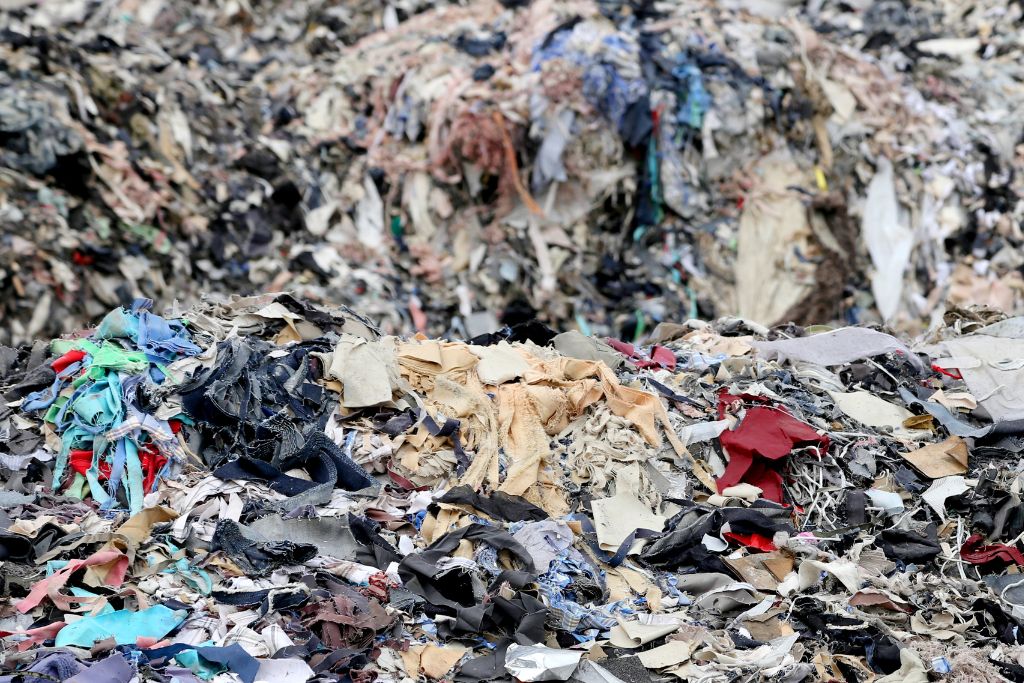As fashion’s environmental toll mounts, these small clothes makers embrace sustainability – Eco-Business

Report on Sustainable Practices and SDG Alignment in the Textile Sector
Gonser Group’s Initiatives for Sustainable Development
The Gonser Group is implementing a comprehensive sustainability strategy to reduce its environmental footprint, directly contributing to several Sustainable Development Goals (SDGs). The company’s efforts are driven by a commitment to future generations and the increasing demand for sustainable products in European markets.
Key Initiatives and SDG Contributions
- SDG 7 (Affordable and Clean Energy) & SDG 13 (Climate Action): The company plans to install 300 kilowatts of solar panels by 2026. This initiative is projected to reduce electricity consumption by 40%, significantly lowering carbon emissions.
- SDG 6 (Clean Water and Sanitation) & SDG 12 (Responsible Consumption and Production): Gonser Group is evaluating an automated chemical dosing system to decrease chemical usage by 25%. This complements its existing practice of recycling up to 90% of its water and certifying over 90% of its chemicals against the ZDHC environmental standard for apparel makers.
- SDG 8 (Decent Work and Economic Growth): By investing in sustainability, the company aims to secure its business activities and expand into new markets, thereby ensuring continued economic growth and employment.
The Role of UNEP’s InTex Programme in Advancing Global Goals
The United Nations Environment Programme (UNEP) InTex programme is instrumental in fostering sustainability across the textile industry, with a focus on small and medium enterprises (SMEs). The programme’s success has been recognized by the European Union for its contribution to a more sustainable global textiles industry.
Programme Achievements and Strategic Expansion
- Capacity Building for SDG 12: Since its 2020 launch, InTex has trained 230 company representatives in circularity and supported 32 SMEs in developing roadmaps to reduce their environmental and socio-economic impacts.
- Fostering Innovation and Economic Growth (SDG 8 & SDG 9): The programme helps companies improve efficiency and cut costs, giving smaller businesses a competitive edge. It is now expanding to India and Indonesia to assist 60 more businesses.
- Enhancing Partnerships (SDG 17): InTex facilitates collaboration across the supply chain. By influencing the procurement criteria of international brands, the programme promotes systemic changes that decrease the overall environmental impacts of production. It also aims to improve access to financing for SMEs, which often face challenges in securing loans for sustainable upgrades.
Analysis of Sustainable Development Goals (SDGs) in the Article
1. Which SDGs are addressed or connected to the issues highlighted in the article?
The article highlights several initiatives and goals of the Gonser Group and the UNEP InTex programme that directly connect to the following Sustainable Development Goals:
- SDG 6: Clean Water and Sanitation
The article explicitly mentions water management practices. Gonser Group’s effort to “recycle up to 90 per cent of its water” directly addresses the need for responsible water use in industrial processes. - SDG 7: Affordable and Clean Energy
The plan to “install 300 kilowatts of solar panels on the factory’s roof by 2026” is a clear initiative towards adopting renewable energy sources and increasing energy efficiency. - SDG 8: Decent Work and Economic Growth
The article discusses how sustainability measures help companies “improve efficiency, cut costs, and meet the growing demand from sustainable markets,” which contributes to economic growth. It also mentions the InTex programme’s work to “improve access to financing for small textile makers,” supporting small and medium enterprises (SMEs). - SDG 9: Industry, Innovation, and Infrastructure
The adoption of new technologies like an “automated chemical dosing system” and the installation of solar panels represent an upgrade of industrial processes and infrastructure to make them more sustainable and efficient. - SDG 12: Responsible Consumption and Production
This is a central theme. The article focuses on reducing the “environmental footprint” of the textile industry through measures like cutting chemical use, recycling water, and promoting circularity. The InTex programme helps companies develop “roadmaps for reducing their environmental and socio-economic impact.” - SDG 17: Partnerships for the Goals
The entire initiative described is a multi-stakeholder partnership. The UNEP’s InTex programme, supported by the European Union, works with private companies like Gonser Group to achieve sustainability goals. The programme’s expansion to India and Indonesia further demonstrates a global partnership in action.
2. What specific targets under those SDGs can be identified based on the article’s content?
Based on the actions described, the following specific SDG targets can be identified:
- Target 6.4: By 2030, substantially increase water-use efficiency across all sectors and ensure sustainable withdrawals and supply of freshwater to address water scarcity.
Evidence: The company’s practice of recycling “up to 90 per cent of its water” is a direct measure to increase water-use efficiency in the industrial sector. - Target 7.2: By 2030, increase substantially the share of renewable energy in the global energy mix.
Evidence: The plan to “install 300 kilowatts of solar panels” is an action aimed at increasing the share of renewable energy in the factory’s energy consumption. - Target 9.4: By 2030, upgrade infrastructure and retrofit industries to make them sustainable, with increased resource-use efficiency and greater adoption of clean and environmentally sound technologies and industrial processes.
Evidence: The article mentions retrofitting the factory with solar panels and evaluating an “automated chemical dosing system” to cut chemical use, which are examples of adopting cleaner and more efficient technologies. - Target 12.4: By 2020, achieve the environmentally sound management of chemicals and all wastes throughout their life cycle… and significantly reduce their release to air, water and soil.
Evidence: The company is working to “cut the factory’s chemical use by 25 per cent” and has “certified that more than 90 per cent of the chemicals it uses meet an environmental standard.” - Target 12.6: Encourage companies, especially large and transnational companies, to adopt sustainable practices and to integrate sustainability information into their reporting cycle.
Evidence: The InTex programme explicitly supports “small and medium enterprises develop roadmaps for reducing their environmental and socio-economic impact” and trains representatives in “circularity,” encouraging the adoption of sustainable practices. - Target 17.17: Encourage and promote effective public, public-private and civil society partnerships, building on the experience and resourcing strategies of partnerships.
Evidence: The article describes the InTex programme as a partnership between UNEP (a public international organization), the European Union (public), and private sector companies. It has supported “32 small and medium enterprises” and is expanding globally.
3. Are there any indicators mentioned or implied in the article that can be used to measure progress towards the identified targets?
Yes, the article provides several quantitative and qualitative indicators that can be used to measure progress:
- For Target 6.4 (Water-use efficiency):
The percentage of water recycled is a direct indicator. The article states a figure of “up to 90 per cent.” - For Target 7.2 (Renewable energy share):
Progress can be measured by the capacity of renewable energy installed (“300 kilowatts of solar panels”) and the resulting reduction in conventional electricity use (“cut electricity use by 40 per cent”). - For Target 12.4 (Sound management of chemicals):
Indicators include the percentage reduction in chemical use (“cut the factory’s chemical use by 25 per cent”) and the percentage of chemicals that are certified against an environmental standard (“more than 90 per cent of the chemicals it uses meet an environmental standard”). - For Target 12.6 (Adoption of sustainable practices):
The number of companies participating in sustainability programs is a key indicator. The article mentions “32 small and medium enterprises” have been supported, with plans to work with “60 more.” The number of people trained (“230 company representatives have been trained in circularity”) is another metric.
4. Table of SDGs, Targets, and Indicators
| SDGs | Targets | Indicators Identified in the Article |
|---|---|---|
| SDG 6: Clean Water and Sanitation | 6.4: Substantially increase water-use efficiency across all sectors. | Percentage of water recycled (up to 90%). |
| SDG 7: Affordable and Clean Energy | 7.2: Increase substantially the share of renewable energy. | Kilowatts of solar panels installed (300 kW); Percentage of electricity use cut (40%). |
| SDG 9: Industry, Innovation, and Infrastructure | 9.4: Upgrade infrastructure and retrofit industries to make them sustainable. | Adoption of automated systems (chemical dosing system); Installation of clean energy infrastructure (solar panels). |
| SDG 12: Responsible Consumption and Production | 12.4: Achieve the environmentally sound management of chemicals. 12.6: Encourage companies to adopt sustainable practices. |
Percentage reduction in chemical use (25%); Percentage of chemicals meeting an environmental standard (over 90%); Number of SMEs developing sustainability roadmaps (32, aiming for 60 more). |
| SDG 17: Partnerships for the Goals | 17.17: Encourage and promote effective public-private partnerships. | Existence of a multi-stakeholder programme (UNEP’s InTex); Number of partners (UNEP, EU, private companies); Geographic expansion of the partnership (India, Indonesia). |
Source: eco-business.com

What is Your Reaction?
 Like
0
Like
0
 Dislike
0
Dislike
0
 Love
0
Love
0
 Funny
0
Funny
0
 Angry
0
Angry
0
 Sad
0
Sad
0
 Wow
0
Wow
0















































































